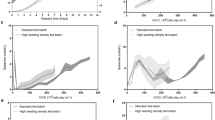Abstract
The hybridoma cell line, HB-8696, produces a monoclonal antibody, 520C9 (mouse IgG1) that recognizes the breast cancer oncoprotein, c-erbB2. The effect of perfusion rate (volume of fresh feed/working volume of reactor/day) on cell growth and mAb production was investigated but perfusion at a constant rate and at an arbitrarily increased rate could not maintain exponential cell growth or a higher specific mAb production rate. An optimum step-up/step-down perfusion strategy is therefore proposed for maintaining a steady state production phase at high cell density for ten days. The optimum step-up perfusion could achieve fast cell growth by avoiding any nutrient limited condition and the following optimum step-down perfusion could potentially maintain high live cell density and reduced product dilution as well. The maximum viable cell achieved under optimum perfusion strategy was 2.3 × 107 cells/ml which was 19-fold higher than in optimum batch culture. The mAb yield and volumetric productivity were significantly improved to 52 and 50 mg/l day compared to 25 and 3.8 mg/l day in optimum batch, respectively, and could be maintained for up to ten days.







Similar content being viewed by others
References
Banik GG, Heath CA (1995) Hybridoma growth and antibody production as a function of cell density and specific growth rate in perfusion culture. Biotechnol Bioeng 48(3):289–300
Banik GG, Heath CA (1996) High-density hybridoma perfusion culture-limitation vs inhibition. Appl Biochem Biotechnol 61(3):211–229
Chan AC, Carter PJ (2010) Therapeutic antibodies for autoimmunity and inflammation. Nat Rev Immunol 10(5):301–316
Deo YM, Mahadevan MD, Fuchs R (1996) Practical considerations in operation and scale-up of spin-filter based bioreactors for monoclonal antibody production. Biotechnol Prog 12:57–64
Dong H, Tang YJ, Ohashi R, Hamel JFP (2005) A perfusion culture system using a stirred ceramic membrane reactor for hyperproduction of IgG(2a) monoclonal antibody by hybridoma cells. Biotechnol Prog 21(1):140–147
Jager M, Schoberth A, Ruf P, Hess J, Lindhofer H (2009) The trifunctional antibody ertumaxomab destroys tumor cells that express low levels of human epidermal growth factor receptor 2. Cancer Res 69(10):4270–4276
Krampe B, Al-Rubeai M (2010) Cell death in mammalian cell culture: molecular mechanisms and cell line engineering strategies. Cytotechnology 62(3):175–188
Lecina M, Tinto A, Galvez J, Godia F, Cairo JJ (2011) Continuous perfusion culture of encapsulated hybridoma cells. J Chem Technol Biotechnol 86(12):1555–1564
Ozturk SS, Thrift JC, Blackie JD, Naveh D (1997) Real-time monitoring and control of glucose and lactate concentrations in a mammalian cell perfusion reactor. Biotechnol Bioeng 53(4):372–378
Press MF, Sauter G, Bernstein L, Villalobos IE, Mirlacher M, Zhou JY, Wardeh R, Li YT, Guzman R, Ma YL, Sullivan-Halley J, Santiago A, Park JM, Riva A, Slamon DJ (2005) Diagnostic evaluation of HER-2 as a molecular target: an assessment of accuracy and reproducibility of laboratory testing in large, prospective, randomized clinical trials. Clin Cancer Res 11(18):6598–6607
Sen S, Roychoudhury PK (2012) Development of optimal medium for production of commercially important monoclonal antibody 520C9 by hybridoma cell. Cytotechnology. doi:101007/s10616-012-9480-z
Shi T, Eaton AM, Ring DB (1991) Selection of hybrid hybridomas by flow-cytometry using a new combination of fluorescent vital stains. J Immunol Methods 141(2):165–175
Slamon DJ, Leyland-Jones B, Shak S, Fuchs H, Paton V, Bajamonde A, Fleming T, Eiermann W, Wolter J, Pegram M, Baselga J, Norton L (2001) Use of chemotherapy plus a monoclonal antibody against HER2 for metastatic breast cancer that overexpresses HER2. N Engl J Med 344(11):783–792
Vermasvuori R, Hurme M (2011) Economic comparison of diagnostic antibody production in perfusion stirred tank and in hollow fiber bioreactor processes. Biotechnol Prog 27(6):1588–1598
Warnock JN, Al-Rubeai M (2006) Bioreactor systems for the production of biopharmaceuticals from animal cells. Biotechnol Appl Biochem 45:1–12
Yang JD, Angelillo Y, Chaudhry M, Goldenberg C, Goldenberg DM (2000) Achievement of high cell density and high antibody productivity by a controlled-fed perfusion bioreactor process. Biotechnol Bioeng 69(1):74–82
Acknowledgments
We thank the Department of Biotechnology (DBT), Govt. of India, New Delhi for providing financial support during the work done.
Author information
Authors and Affiliations
Corresponding author
Electronic supplementary material
Below is the link to the electronic supplementary material.
Rights and permissions
About this article
Cite this article
Sen, S., Roychoudhury, P.K. Step-up/step-down perfusion approach for increased mAb 520C9 production by a hybridoma cell line. Biotechnol Lett 35, 153–163 (2013). https://doi.org/10.1007/s10529-012-1058-5
Received:
Accepted:
Published:
Issue Date:
DOI: https://doi.org/10.1007/s10529-012-1058-5




